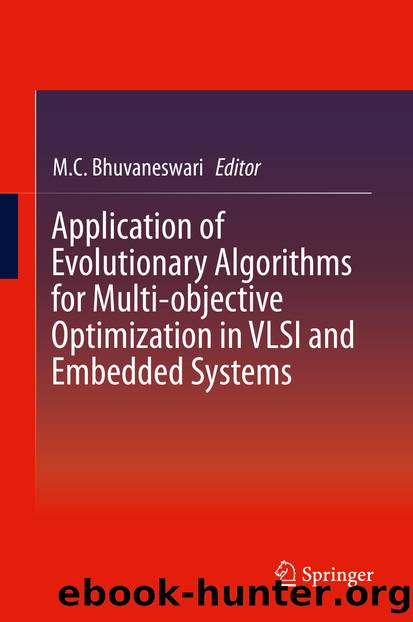Application of Evolutionary Algorithms for Multi-objective Optimization in VLSI and Embedded Systems by M. C. Bhuvaneswari

Author:M. C. Bhuvaneswari
Language: eng
Format: epub
Publisher: Springer India, New Delhi
Fig. 5.7Solutions for WSGA (Deb 2008)
Deb et al. proposed the “Non-Dominated Sorting GA-II” or NSGA-II (Deb et al. 2002), which is a true multi-objective GA. It uses the notion of crowding distance to ensure diversity among the solutions in a population. Initially, a random seed is created. Chromosome encoding and objective functions are same as WSGA. The cost of each objective for all the solutions in determined and they are classified into Ranks based on non-dominance. The Rank I individuals are fully non-dominated whereas those in Rank 2 are dominated by the Rank I individuals and so on. Each solution is assigned a fitness based on its Rank and Crowding Distance. The Crowding Distance is a measure of the uniqueness of a solution. Crossover and mutation are performed on the individuals using the method described in (Krishnan and Katkoori 2006). The parents and offspring in a particular generation are merged and the individuals for the next generation are selected based on the crowding distance metric (Deb et al. 2002; Deb 2008). Selection of individuals with higher crowding distance is favored for better diversity among solutions. A population size of 100 is used in each generation and the algorithm is run for 200 generations. A flow diagram depicting the NSGA-II methodology for DFG scheduling is shown in Fig. 5.8.
Fig. 5.8NSGA-II based methodology for DFG scheduling
Download
This site does not store any files on its server. We only index and link to content provided by other sites. Please contact the content providers to delete copyright contents if any and email us, we'll remove relevant links or contents immediately.
API Testing and Development with Postman by Dave Westerveld(3998)
Learning C# by Developing Games with Unity 2020 by Harrison Ferrone(2980)
Software Architecture for Busy Developers by Stéphane Eyskens(2747)
2021 Beginners Guide to Python Programming Language: A Crash Course to Mastering Python in One Hour by Elmer Gary & Elmer Gary(1903)
Machine Learning for Algorithmic Trading by Stefan Jansen(1658)
Hands-On ROS for Robotics Programming by Bernardo Ronquillo Japón(1591)
Delphi GUI Programming with FireMonkey by Andrea Magni(1481)
Game Development Projects with Unreal Engine by Hammad Fozi & Goncalo Marques & David Pereira & Devin Sherry(1436)
Cloud Native with Kubernetes by Alexander Raul(1395)
Datadog Cloud Monitoring Quick Start Guide by Thomas Kurian Theakanath(1361)
Software Architecture Patterns for Serverless Systems by John Gilbert(1356)
Practical Node-RED Programming by Taiji Hagino(1349)
Automate It with Zapier by Kelly Goss(1336)
Practical System Programming for Rust Developers by Prabhu Eshwarla(1333)
Delphi Programming Projects by William Duarte(1317)
Mastering React Test-Driven Development by Daniel Irvine(1309)
Developing Multi-Platform Apps with Visual Studio Code by Ovais Mehboob Ahmed Khan & Khusro Habib & Chris Dias(1275)
Ghidra Software Reverse Engineering for Beginners by A. P. David(1261)
Learn Spring for Android Application Development by S. M. Mohi Us Sunnat(1256)
